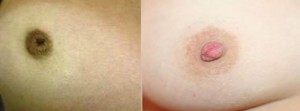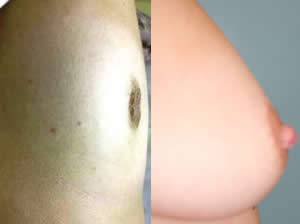Say Goodbye to Inverted Nipples!

Do your inverted nipples make you self-conscious or insecure about your appearance? The solution to your problem may be easier than you think—many women are affected by this condition, but you don’t have to continue to be one of them! Read on to learn more about why nipples become inverted, and how to get them to come out of hiding with inverted nipple surgery!
How does a nipple get inverted?
There are a few ways that nipples become inverted. Scarring from breastfeeding can cause it; so can an infection in the breast’s milk ducts, or even a previous breast surgery…but in most cases, inverted nipples come about naturally, as the breast develops. This happens because the tissues inside the breast that connect the nipple to the rest of your breast tissue are constraining the milk ducts—they’re basically tugging the nipple inward, holding it back. It’s important to note that inverted nipples can be a sign of breast cancer. However, unless the retraction of the nipples has occurred suddenly and inexplicably, there’s no need to worry.
Can inverted nipples be fixed?
Absolutely! In fact, inverted nipples can be fixed with a pretty simple surgical procedure that can take as little as 30 minutes to perform. Since in most cases nipple inversion is caused by that tethering of the ducts described above, the problem can be resolved by making a small incision into the nipple. This severs the fibers and ducts that are holding the nipple in, and the nipple is able to evert. Sometimes the doctor will also place bolsters inside the breast to keep the nipples from retracting back in, which they generally leave in for 2-3 weeks.
Actually, inverted nipples don’t always require surgery—sometimes simply stimulating the area and manually pulling the nipple out can be enough to make it evert. This only works in milder cases, though, and for many patients stimulating the nipple is not enough to address the issue; the majority of inverted nipples do require surgery.
Will I have a scar if I get them fixed?
The incision for inverted nipple surgery is tiny—so tiny, in fact, that it only takes a few small sutures to close it up! If a skilled surgeon performs the procedure, the scar should be virtually invisible.
Can they invert again after surgery?
Nipples can sometimes retract again following nipple repair surgery. This can happen anywhere between months and years after the surgery is performed. That said, inverted nipple corrective surgery has a high success rate, and nipple inversion recurrence isn’t common.
Will I be able to breastfeed after inverted nipple repair surgery?

Inverted Nipples Before After Photo (Actual Patient. Dr. Rajagopal)
Inverted Nipples Before After Photo (Actual Patient. Dr. Rajagopal) Unfortunately, it’s pretty likely that you won’t be able to breastfeed after your nipple repair surgery. The incision made in this procedure usually severs the milk ducts in the breast—and if the milk can’t make its way to the nipple, nursing is off the table. There are some corrective procedures that are designed to preserve the milk ducts, but severe cases of inverted nipples almost always require that the ducts be divided. Because of this, many doctors recommend that if you plan to have children—and you want to breastfeed them—you wait until after you’ve finished nursing to have the surgery done. Another good reason to wait: inverted nipples sometimes come out on their own during pregnancy! Many women with inverted nipples are able to breastfeed their children without having undergone a corrective procedure.
Talk to Your Doc
Clearly there are some things to consider when it comes to nipple repair surgery, especially if you want to able to breastfeed children in the future. But if you’re embarrassed by your condition and you want to make a change, talk to your doctor—they’ll help you find a solution that works for you!